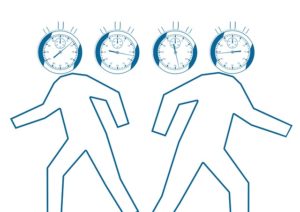
The Mental Elf has previously blogged about the finding that those with depression may have a life expectancy up to 10 years shorter than those in the general population. It has now been suggested that this increased risk of premature mortality may be at least partly owing to higher rates of cardiovascular and metabolic disease (Charlson et al, 2013).
Typically, exercising and leading a generally active lifestyle can keep these at bay, but symptoms such as lack of motivation and fatigue can make this more difficult for people with depression. Additionally, lower levels of physical activity are associated with an increased risk of depression, and people are typically less active when depressed (De Moor et al, 2006), although exercise has been shown to improve depressive symptoms.
Schuch and colleagues investigated this complex relationship in a recent systematic review on the levels of physical activity and sedentary behaviour in people with depression.
The study aimed to:
- Establish the mean amount of physical activity and sedentary behaviour per day among people with major depressive disorder (MDD)
- Investigate predictors of physical activity and sedentary behaviour through meta-regression analyses
- Establish the proportion of people with MDD that meet the public health recommendation of 150 min of Moderate to Vigorous Physical Activity (MVPA) per week
- Explore differences in physical activity and sedentary behaviour in people with MDD versus age- and gender-matched healthy controls
- Evaluate differences between physical activity and sedentary behaviour measured using self-report questionnaires (SRQs) and objective measures.

Ask anyone who’s been depressed and unmotivated: it’s often hard to exercise when depressed.
Methods
The authors included studies that:
- Involved adult participants with a formal diagnosis of major depressive disorder
- Were interventional or observational studies
- Used a valid measure of physical activity and sedentary behaviour
- Had been published in an international peer-reviewed journal.
The primary outcome was the mean time in minutes per day that people with depression were sedentary or engaged in physical activity (in total, and separately by level of vigour). Data on this behaviour among healthy controls was also collected where possible, along with any reported data on the proportion of people with depression who achieved 150 minutes of physical activity per week. Sedentary behaviour (SB) was defined as an energy expenditure ≤1.5 metabolic equivalents of task (METs), while in a sitting or reclining posture during waking hours. Physical activity (PA) was defined as any bodily movement produced by skeletal muscles which requires energy expenditure. One author extracted these data from the included studies, and a second validated this.
Results
Out of 8,103 initial results, 24 unique studies were included in the final analyses, comprising 2,901 individuals with major depressive disorder (MDD) (78.4% female, mean age = 54 years). Ten studies reported data from control participants (n = 3,783, 63.18% female, mean age = 48.5 years).
The authors calculated the mean number of minutes spent in physical activity (PA) and sedentary behaviour (SB) per day, and found that people with MDD spent on average:
- 126 minutes per day engaged in any PA (95% CI 91.9 to 160.4);
- 9 minutes in light PA (95% CI 90.6 to 189.3);
- 3 minutes in moderate PA (95% CI 42.7 to 79.8);
- 6 minutes in moderate to vigorous PA (95% CI 27.4 to 47.9);
- 3 minutes in vigorous PA (95% CI 2.5 to 8.1);
- and 8.5 hours per day sedentary (95% CI 7.4 to 9.6).
Additionally, 67.8% (95% CI 52.1 to 80.3) did not comply with the recommendation of 150 minutes of PA per week.
The subgroup analyses suggested that self-report questionnaires underestimate the amount of total PA and light PA undertaken by those with depression, compared with data from objective measures. However, it was also found that they underestimated the amount of SB and the number of participants not meeting the recommended guideline, and overestimated the amount of vigorous PA undertaken.
Those living in the community spent significantly less time engaged in PA (in total) than inpatients, outpatients or studies evaluating people living in mixed settings. Tallying with this, participants living in the community spent significantly more time in SB than outpatients or those in a mixed setting. However, the proportion of participants not reaching 150 minutes of PA per week was higher in outpatients than in community or mixed samples.
In terms of the differences in PA and SB between MDD patients and healthy controls, Schuch et al. found that those with depression:
- Spent significantly less time undertaking any PA (mean difference: 11.6 minutes)
- Were sedentary for significantly more time per day (mean difference: 0.2 hours, or 12 minutes)
- Were significantly less likely than controls to meet the recommended guidelines of 150 minutes of PA per week (odds ratio: 1.5).
Publication bias was only identified in the light PA comparison (deemed to be slight), and in the vigorous PA comparison.

This review found that more than two-thirds of people with depression did not comply with the recommendation of 150 minutes of physical activity per week.
Strengths and limitations
Besides contributing to the literature surrounding an important public health concern, this study has a number of strengths:
- Providing a comparison point with healthy controls allows the primary outcome data of this study to be put into context. In particular, whilst we can see that there are significant differences between those with depression and controls in terms of PA and SB, this doesn’t actually equate to a huge amount of time; around 12 minutes per day.
- The 24 included studies amount to a large number of participants, so whilst sub-analyses used a reduced sample of studies, the smallest comparison still had over 600 participants.
However, several limitations should be considered:
- Whilst some significant differences were observed between those with MDD and healthy controls, the controls were younger on average, which could have affected the results.
- The sub-analyses provide some food for thought, but it is important to note that the studies included were not designed or powered to answer these questions; for example, none of the studies directly compared SRQs with objective measures. In fact, very few studies used objective measures overall, so this comparison in particular should be taken with a pinch of salt.
- The authors note that there was a large amount of heterogeneity for most analyses, which may be contributed to by the differences in settings and measures between studies.
- It would have been interesting to consider these results in the context of antidepressants and depressive symptoms and their impact on PA and SB. The authors note that this data was not available in the included studies, so future research should incorporate symptom severity measures and medication data.

Providing a comparison point with healthy controls allows the primary outcome data of this study to be put into context.
Conclusions and implications
The authors describe review this as a demonstration that:
People with MDD [major depressive disorder] engage in low levels of physical activity.
They cite the finding that people with MDD are 50% less likely to meet the recommended physical activity (PA) guidelines. Healthcare professionals should therefore encourage less sedentary behaviour in this population, promoting strategies such as walking instead of taking motorised transport and perhaps including physical activity in care plans. The results presented by Schuch and colleagues regarding different healthcare settings is mixed, with some striking differences of over 300 minutes per day, warranting further study. Nevertheless, it does appear to suggest that community and outpatient settings may come off worse, perhaps owing to a reduced availability of encouragement from healthcare professionals.
This study suggests that self-report measures are not as valid as we might hope in this population, but this varies depending on the outcome (for example, total PA is underestimated but vigorous PA is overestimated). This provides support for future studies using objective measures such as wearable fitness technology, although they may be more costly.
There is no doubt that looking after the physical and mental health of those with a mental illness should be a priority, and that physical activity is likely to be an effective route to doing so. Nevertheless, this study seems to suggest that, while some differences can be observed, those with a diagnosis of MDD are not engaging in levels of physical activity far lower than those in the general population. Perhaps it is the case, then, that people on the whole are too sedentary – indeed, global physical inactivity is estimated to be occurring in around 30% of the population (Hallal et al., 2012). It just may be that those with a mental illness stand to gain the most from rectifying this.

Future studies should consider using objective measures such as wearable fitness technology.
Links
Primary paper
Schuch F, Vancampfort D, Firth J, et al (2017) Physical activity and sedentary behavior in people with major depressive disorder: a systematic review and meta-analysis. Journal of Affective Disorders 2017. [PubMed abstract]
Other references
Charlson FJ, Moran AE, Freedman G, et al (2013) The contribution of major depression to the global burden of ischemic heart disease: a comparative risk assessment (PDF). BMC Medicine.
De Moor MHM, Beem AL, Stubbe JH, et al (2006) Regular exercise, anxiety, depression and personality: a population-based study (PDF). Preventive Medicine.
Hallal PC, Andersen LB, Bull FC, et al (2012) Global physical activity levels: surveillance progress, pitfalls, and prospects. The Lancet.
Photo credits
- Photo by elizabeth lies on Unsplash
- Bianca Moraes CC BY 2.0

Excellent work and findings. Great effort by psychiatrist to promote physical activity in depressed patients and by social policies in making it accessible.